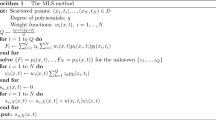Abstract
The essential features of the Meshless Local Petrov-Galerkin (MLPG) method, and of the Local Boundary Integral Equation (LBIE) method, are critically examined from the points of view of a non-element interpolation of the field variables, and of the meshless numerical integration of the weak form to generate the stiffness matrix. As truly meshless methods, the MLPG and the LBIE methods hold a great promise in computational mechanics, because these methods do not require a mesh, either to construct the shape functions, or to integrate the Petrov-Galerkin weak form. The characteristics of various meshless interpolations, such as the moving least square, Shepard function, and partition of unity, as candidates for trial and test functions are investigated, and the advantages and disadvantages are pointed out. Emphasis is placed on the characteristics of the global forms of the nodal trial and test functions, which are non-zero only over local sub-domains Ωtr J and Ωte I, respectively. These nodal trial and test functions are centered at the nodes J and I (which are the centers of the domains Ωtr J and Ωte I), respectively, and, in general, vanish at the boundaries ∂Ωtr J and ∂Ωte I of Ωtr J and Ωte I, respectively. The local domains Ωtr J and Ωte I can be of arbitrary shapes, such as spheres, rectangular parallelopipeds, and ellipsoids, in 3-Dimensional geometries. The sizes of Ωtr J and Ωte I can be arbitrary, different from each other, and different for each J, and I, in general. It is shown that the LBIE is but a special form of the MLPG, if the nodal test functions are specifically chosen so as to be the modified fundamental solutions to the differential equations in Ωte I, and to vanish at the boundary ∂Ωte I. The difficulty in the numerical integration of the weak form, to generate the stiffness matrix, is discussed, and a new integration method is proposed. In this new method, the Ith row in the stiffness matrix is generated by integrating over the fixed sub-domain Ωte I (which is the support for the test function centered at node I); or, alternatively the entry K I J in the global stiffness matrix is generated by integrating over the intersections of the sub-domain Ωtr J (which is the sub-domain, with node J as its center, and over which the trial function is non-zero), with Ωte I (which is the sub-domain centered at node I over which the test function is non-zero). The generality of the MLPG method is emphasized, and it is pointed that the MLPG can also be the basis of a Galerkin method that leads to a symmetric stiffness matrix. This paper also points out a new but elementary method, to satisfy the essential boundary conditions exactly, in the MLPG method, while using meshless interpolations of the MLS type. This paper presents a critical appraisal of the basic frameworks of the truly meshless MLPG/LBIE methods, and the numerical examples show that the MLPG approach gives good results. It now apears that the MLPG method may replace the well-known Galerkin finite element method (GFEM) as a general tool for numerical modeling, in the not too distant a future.
Similar content being viewed by others
Author information
Authors and Affiliations
Additional information
Received 15 January 1999
Rights and permissions
About this article
Cite this article
Atluri, S., Kim, HG. & Cho, J. A critical assessment of the truly Meshless Local Petrov-Galerkin (MLPG), and Local Boundary Integral Equation (LBIE) methods. Computational Mechanics 24, 348–372 (1999). https://doi.org/10.1007/s004660050457
Issue Date:
DOI: https://doi.org/10.1007/s004660050457




